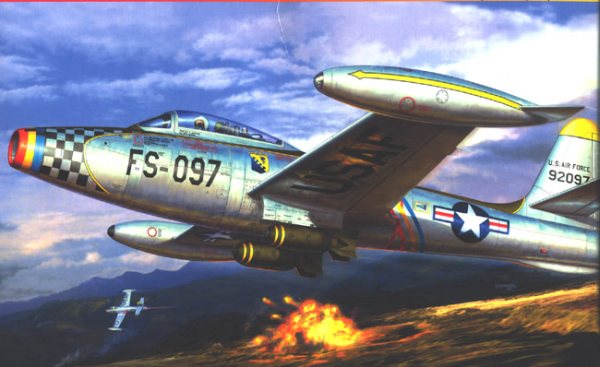
Revell 1/48 F-84E Thunderjet
|
KIT # |
5494 |
|
PRICE: |
$16.05 MSRP |
|
DECALS: |
Two Aircraft |
|
REVIEW: |
Norris Graser |
|
NOTES: |
Historyl Section by your editor, Scott Van Aken |

|
HISTORY |
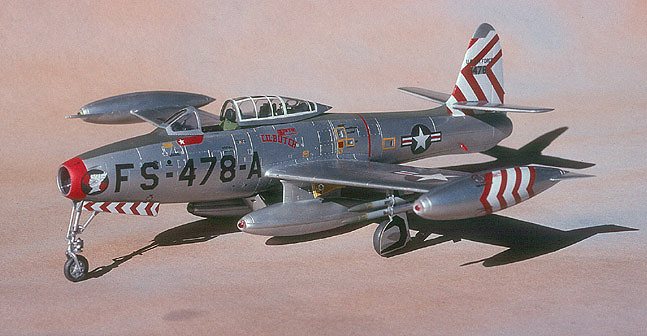
The F-84E was the second really useful F-84. The A,B and C models were hampered by J-35 engines that were, for a better description, grossly underpowered. In fact, thanks to the protracted development of these engines by Alison, the F-84 was considered by many to be obsolescent by the time it finally reached squadron service!
Finally, the J-35-17 engine was available for the F-84D and the plane had enough thrust to allow the airframe to be fully utilized. Power was especially important for the fighter-bomber role as without it, a decent war load could not be carried. Even then, the turbojets of the day were not enough for the heavier loads and strap on RATO units were frequently needed to lift the aircraft and its ordnance load.
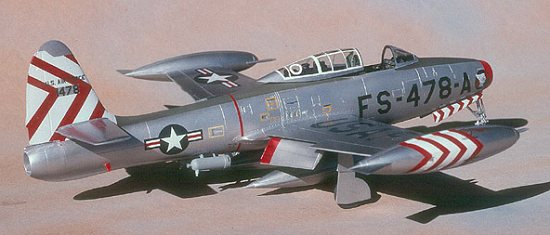 The two most
successful variants were the F-84E and G models. These were basically very
similar airframes; the biggest difference was that the Gs were capable of
carrying nuclear weapons and had a built-in air refueling door for the USAF's
choice of air to air refueling; the boom system. The Navy still uses the probe
and drogue system as it does not require a specialized operator, as does the
usually man-power intensive USAF. It is this author's experience in maintaining
Naval aircraft, that what it takes two to three Sailors or Marines to do, the
USAF requires a dozen people!!
The two most
successful variants were the F-84E and G models. These were basically very
similar airframes; the biggest difference was that the Gs were capable of
carrying nuclear weapons and had a built-in air refueling door for the USAF's
choice of air to air refueling; the boom system. The Navy still uses the probe
and drogue system as it does not require a specialized operator, as does the
usually man-power intensive USAF. It is this author's experience in maintaining
Naval aircraft, that what it takes two to three Sailors or Marines to do, the
USAF requires a dozen people!!
Anyway, the F-84E was the plane that Republic had meant to build in the first place. It was rugged, fairly easy to maintain, and could carry the required war load. The perfect fighter-bomber. Many were fitted out with F-84G components such as the perforated speed brake and the reinforced canopy. However, there are two external clues, one easier to spot than the other. The E has no forward fuselage intake doors and it also has a slightly longer tail section with repositioned aft lights.
|
THE KIT |
Revell has filled Another hole in the early 50s category of military aircraft with the release of their F-84E Thunderjet. This is an easy model to build, requiring you to spend more time painting and decaling then actually putting it together. As you will see, this is a versatile kit that allows you to build an early E or later vintage model. If you have the Revell F-84G kit, you can snatch the speed brake and use it as a late mod on the E or make an early G version as they were produced with the E type brake. Heck, you have both an etched metal and plastic speed brake in the G kit; which means you've got a spare!
There are only a few areas of concern on the model, principally the nose gear/wheel well, a two piece affair which leaves a very difficult seam to fill and sand. This is the same problem found in the wheel well of the Tamiya F-84G, prompting at least two aftermarket resin companies to offer up solid counterparts to replace kit parts. Yes, a darn near perfect model!
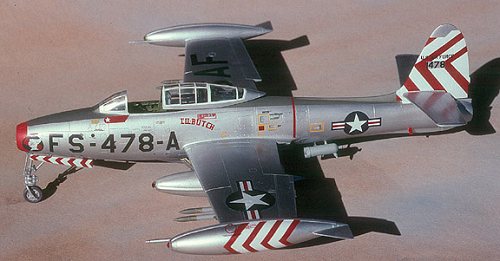 The model features
several parts, specific to the F-84E, which are not found in the previous F-84G
release, allowing you to make an early or late version of the F-84E. These
items include an altogether different tail pipe and the earlier speed brake.
Two different types of canopies are also included; one without framing (this
was the original type, used through most of the E series) and a later
reinforced, framed canopy (made for the late Es and all Gs but retrofitted to
most Es' and many earlier marks.).
The model features
several parts, specific to the F-84E, which are not found in the previous F-84G
release, allowing you to make an early or late version of the F-84E. These
items include an altogether different tail pipe and the earlier speed brake.
Two different types of canopies are also included; one without framing (this
was the original type, used through most of the E series) and a later
reinforced, framed canopy (made for the late Es and all Gs but retrofitted to
most Es' and many earlier marks.).
Two external "fixes" were necessary so Revell could produce the two variants from common molds. The first involves the forward fuselage. The E had a smooth forward fuselage but the G had a "suck in door" on either side. So you get two rectangular shaped panels sans "suck in doors" to make this an E. There is also an insert for the port wing near the wing root necessitated by the fact that the G had a refueling receptacle in this position and the E did not.
The only item Revell left out is the earlier type seat as the one included in the kit came late in the E production and remained unchanged through the G. Again, seats were retrofitted to earlier built aircraft making it all but impossible to tell which seat was in use with any particular aircraft, unless you have a date for the markings you are going to use on your model.
Other items found in this release, not included in the F-84G version, include a pair of short takeoff RATO bottles and a pair of drop tanks. All of the weapons found in the G are still here, except the atom bomb, as this weapon was only first fitted to the G type Thunderjet
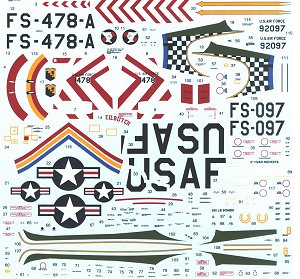 A nice feature common to
both kits is the inclusion of flaps in both lowered and raised configurations.
You will also find the wing tip refueling probes, but you will have to check
references for individual aircraft as they were removable items. As it turns
out, neither aircraft featured on the rather large decal included in the kit had
refueling probes in place. This is based on research for each scheme. (So
eliminate them if you use the kit markings!)
A nice feature common to
both kits is the inclusion of flaps in both lowered and raised configurations.
You will also find the wing tip refueling probes, but you will have to check
references for individual aircraft as they were removable items. As it turns
out, neither aircraft featured on the rather large decal included in the kit had
refueling probes in place. This is based on research for each scheme. (So
eliminate them if you use the kit markings!)
A very useable decal sheet is included with plenty of stenciling and markings for two machines. The first is an early E ( F-84E-1-RE, 49-2097) with the non framed canopy in splashy markings worn by Col Carroll McColpin's jet while he was CO of the 31st Fighter Group at Turner Field, circa 1949. I wonder if McColpin designed this scheme as he also was assigned a P-47 with a checkerboard design when he was CO of the 404th Fighter Group during WWII,. I only note it because checkerboards were not found on any other Thunderbolts in the 404th, just his! The other squadron decal option represented is the 9th Fighter Bomb Squadron, 49th Bomb Wing in Korea, 1952.
|
CONSTRUCTION |
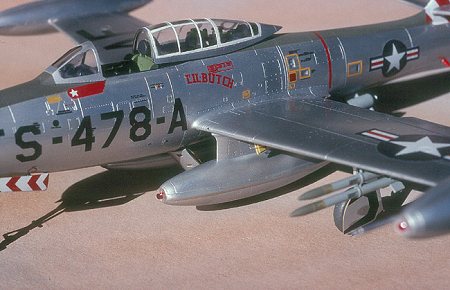 (This won't take long) I'm
not going to go into any great detail here as the layout of the parts and the
fit is very good. I will state that I believe this F-84 ( and the earlier
release of the G) goes together easier then the Tamiya kit, which preceded the
first Revell release by some 6 months. The Tamiya kit has a fit problem on the
forward fuselage gun access panel. This part is not a separate piece on the
Revell kit so, no problem, however both the Revell and Tamiya kit do share a
common problem contained in the nose gear well; the way the parts are assembled
leaves a seam that cannot be easily filled or sanded. I guess it's only
noticeable if you flip your model over and look for it, but it is there. It must
be of concern to some modelers as no less then two resin manufacturers came out
with solid resin pieces to replace the item in the Tamiya kit!!
(This won't take long) I'm
not going to go into any great detail here as the layout of the parts and the
fit is very good. I will state that I believe this F-84 ( and the earlier
release of the G) goes together easier then the Tamiya kit, which preceded the
first Revell release by some 6 months. The Tamiya kit has a fit problem on the
forward fuselage gun access panel. This part is not a separate piece on the
Revell kit so, no problem, however both the Revell and Tamiya kit do share a
common problem contained in the nose gear well; the way the parts are assembled
leaves a seam that cannot be easily filled or sanded. I guess it's only
noticeable if you flip your model over and look for it, but it is there. It must
be of concern to some modelers as no less then two resin manufacturers came out
with solid resin pieces to replace the item in the Tamiya kit!!
There are a few areas of concern, though. I feel almost embarrassed to even
mention this first because its a very minimal fit problem. But because you more
then likely will be working with
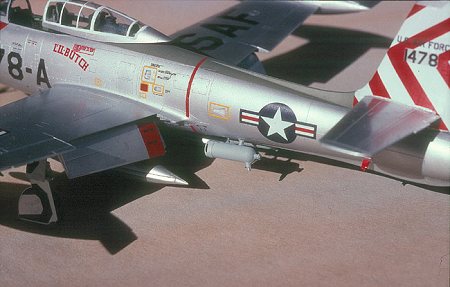 decals that have to follow
the contours of the forward fuselage, the last thing you need is to sand the
hell out of the nose.. I had trouble getting the intake lip ring to fit flush
against the assembled fuselage halves. Had I been paying attention, I would have
test fit the piece another time or two as I'm certain it will fit with some
sanding.
decals that have to follow
the contours of the forward fuselage, the last thing you need is to sand the
hell out of the nose.. I had trouble getting the intake lip ring to fit flush
against the assembled fuselage halves. Had I been paying attention, I would have
test fit the piece another time or two as I'm certain it will fit with some
sanding.
Next up, there are two other assembly procedures that will require some attention. The two fuselage inserts must be glued into place before the fuselage halves are cemented. The port wing root panel should also be added before the wings are assembled. These are very precise fitting pieces, but if you don't pay attention, you can easily misalign them, enough to be noticeable under a metal finish paint job. My advice is to test fit these parts before gluing into place. The left side fuselage insert,( part 77) was a perfect fit, but the right side piece, (part 76) needed a touch of sanding to drop into place. The port wing insert was also a good fit. I would advise gluing these pieces to place from the inside of the fuselage for the fuselage inserts and from the underside of the top wing for the wing insert. Use a liquid glue and you can achieve uniform panel lines After gluing, a light sanding to make sure that the panels level with the surrounding area is advised. Remember though, these parts are a concession by the manufacturer to do both the E and G types, so if you really want to go through the extra effort, feel free to ignore the above and fill & sand the panel lines on these components.
The last item to address is necessary if you choose to use the rockets as your ordinance. The rockets are stacked and will require concentration, patience and steady hands as there is not much of an area to glue to. I spent more time aligning them but the result is worth it.
|
PAINT & DECALS |
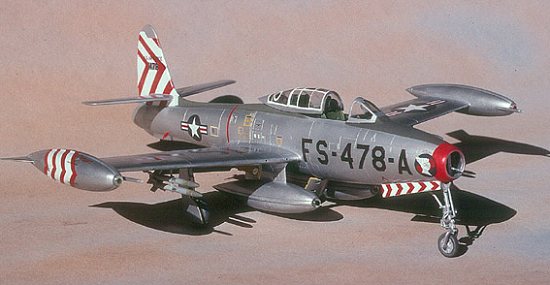 I painted my Thunderjet
using Floquil Old Silver and Bright Silver. For the landing gear I screwed
around with the new Alclad II system. I haven't experimented enough to comment
on the Alclad, as I just kept it to the landing gear. I had no problems and the
result looks ok.
I painted my Thunderjet
using Floquil Old Silver and Bright Silver. For the landing gear I screwed
around with the new Alclad II system. I haven't experimented enough to comment
on the Alclad, as I just kept it to the landing gear. I had no problems and the
result looks ok.
A note about painting the wheel wells; everyone suggests the use of zinc chromate green, but as is the case of the predecessor to the Thunderjet ( that would be the Thunderbolt, of course) use Yellow chromate. I met a man who worked at Republic and he told me they had a LOT of yellow primer and were too cheap to toss it out to go with Chromate Green specs. That's as good a reason as any to explain why everyone else used green except Republic!
|
CONCLUSIONS |
Do I recommend this model? You bet.
|
REFERENCES |
Editor's Note: An excellent reference, which validates all of the wheel well color stuff as well, is F-84 Thunderjet Units in Korea, by Warren Thompson, 2000, Osprey.
Copyright ModelingMadness.com. All rights reserved. No reproduction in part or in whole without express permission.
If you would like your product reviewed fairly and fairly quickly, please contact the editor or see other details in the Note to Contributors.
Back to Reviews Page 2021